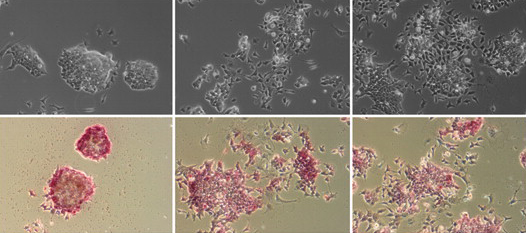Embryonic stem cells – keeping a clean slate
Posted by Erin M Campbell, on 15 August 2011

Do your ears perk up when you hear about embryonic stem cells? We all have heard and/or participated in the controversy surrounding the use of them, yet there is no debate over their biological importance and medical potential. A paper in Journal of Cell Science describes the newly-indentified role for Banf1 in ESC self-renewal.
Embryonic stem cells (ESCs) maintain their pluripotent state through a complicated process called self-renewal. Self-renewal of ESCs is dependent on three main regulators—Sox2, Oct4, and Nanog. Recently, Cox and colleagues conducted a proteomic screen to find proteins that associate with Sox2, and identified the DNA-binding protein Banf1. Banf1 was already known to play important roles in worm and fly development, yet its role in mammalian development was unclear. Cox and colleagues found that Banf1 is required for mouse and human ESC self-renewal. The use of RNAi to reduce Banf1 levels led to differentiation of mouse ESCs into mesoderm and trophectoderm cell lineages. As seen in the images above, Banf1 knockdown (middle and right columns) caused cell to no longer have the characteristic pluripotent ESC morphology (left column). Banf1-reduced cells were more flattened, had more membrane processes, and showed less staining for the pluripotent stem cell marker alkaline phosphatase (red, bottom row). When investigating the specific mechanism likely affected by Banf1 knockdown, Cox and colleagues found that cell cycle distribution was altered in mouse and human ESCs – Banf1 knockdown resulted in a higher portion of cells in G2-M phase, and fewer cells in S-phase.
For a more general description of this image, see my imaging blog within EuroStemCell, the European stem cell portal.
![]() Cox JL, Mallanna SK, Ormsbee BD, Desler M, Wiebe MS, & Rizzino A (2011). Banf1 is required to maintain the self-renewal of both mouse and human embryonic stem cells. Journal of cell science, 124 (Pt 15), 2654-65 PMID: 21750191
Cox JL, Mallanna SK, Ormsbee BD, Desler M, Wiebe MS, & Rizzino A (2011). Banf1 is required to maintain the self-renewal of both mouse and human embryonic stem cells. Journal of cell science, 124 (Pt 15), 2654-65 PMID: 21750191


 (4 votes)
(4 votes)